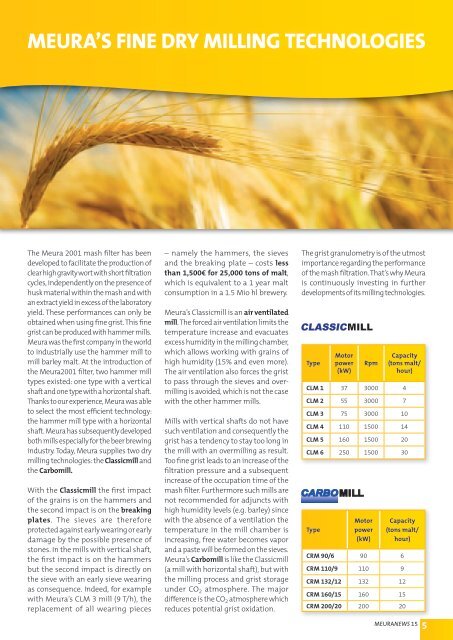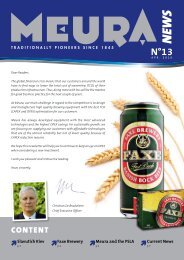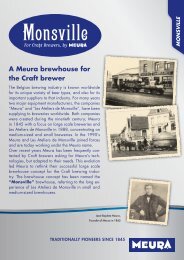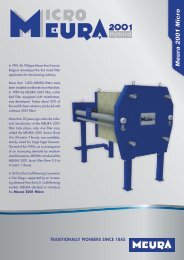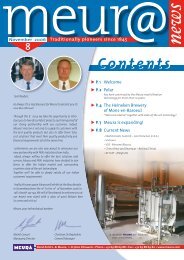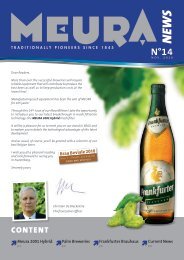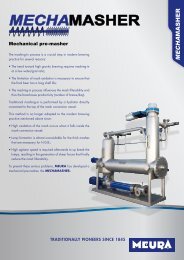NL 15 FINALE.pdf - Meura
NL 15 FINALE.pdf - Meura
NL 15 FINALE.pdf - Meura
Create successful ePaper yourself
Turn your PDF publications into a flip-book with our unique Google optimized e-Paper software.
<strong>Meura</strong>’s fine dry Milling technologies<br />
The <strong>Meura</strong> 2001 mash filter has been<br />
developed to facilitate the production of<br />
clear high gravity wort with short filtration<br />
cycles, independently on the presence of<br />
husk material within the mash and with<br />
an extract yield in excess of the laboratory<br />
yield. These performances can only be<br />
obtained when using fine grist. This fine<br />
grist can be produced with hammer mills.<br />
<strong>Meura</strong> was the first company in the world<br />
to industrially use the hammer mill to<br />
mill barley malt. At the introduction of<br />
the <strong>Meura</strong>2001 filter, two hammer mill<br />
types existed: one type with a vertical<br />
shaft and one type with a horizontal shaft.<br />
Thanks to our experience, <strong>Meura</strong> was able<br />
to select the most efficient technology:<br />
the hammer mill type with a horizontal<br />
shaft. <strong>Meura</strong> has subsequently developed<br />
both mills especially for the beer brewing<br />
industry. Today, <strong>Meura</strong> supplies two dry<br />
milling technologies: the Classicmill and<br />
the Carbomill.<br />
With the Classicmill the first impact<br />
of the grains is on the hammers and<br />
the second impact is on the breaking<br />
plates. The sieves are therefore<br />
protected against early wearing or early<br />
damage by the possible presence of<br />
stones. In the mills with vertical shaft,<br />
the first impact is on the hammers<br />
but the second impact is directly on<br />
the sieve with an early sieve wearing<br />
as consequence. Indeed, for example<br />
with <strong>Meura</strong>’s CLM 3 mill (9 T/h), the<br />
replacement of all wearing pieces<br />
– namely the hammers, the sieves<br />
and the breaking plate – costs less<br />
than 1,500€ for 25,000 tons of malt,<br />
which is equivalent to a 1 year malt<br />
consumption in a 1.5 Mio hl brewery.<br />
<strong>Meura</strong>’s Classicmill is an air ventilated<br />
mill. The forced air ventilation limits the<br />
temperature increase and evacuates<br />
excess humidity in the milling chamber,<br />
which allows working with grains of<br />
high humidity (<strong>15</strong>% and even more).<br />
The air ventilation also forces the grist<br />
to pass through the sieves and overmilling<br />
is avoided, which is not the case<br />
with the other hammer mills.<br />
Mills with vertical shafts do not have<br />
such ventilation and consequently the<br />
grist has a tendency to stay too long in<br />
the mill with an overmilling as result.<br />
Too fine grist leads to an increase of the<br />
filtration pressure and a subsequent<br />
increase of the occupation time of the<br />
mash filter. Furthermore such mills are<br />
not recommended for adjuncts with<br />
high humidity levels (e.g. barley) since<br />
with the absence of a ventilation the<br />
temperature in the mill chamber is<br />
increasing, free water becomes vapor<br />
and a paste will be formed on the sieves.<br />
<strong>Meura</strong>’s Carbomill is like the Classicmill<br />
(a mill with horizontal shaft), but with<br />
the milling process and grist storage<br />
under CO 2 atmosphere. The major<br />
difference is the CO 2 atmosphere which<br />
reduces potential grist oxidation.<br />
The grist granulometry is of the utmost<br />
importance regarding the performance<br />
of the mash filtration. That’s why <strong>Meura</strong><br />
is continuously investing in further<br />
developments of its milling technologies.<br />
Type<br />
Type<br />
Motor<br />
power<br />
(kW)<br />
Rpm<br />
Motor<br />
power<br />
(kW)<br />
Capacity<br />
(tons malt/<br />
hour)<br />
CRM 90/6 90 6<br />
CRM 110/9 110 9<br />
Capacity<br />
(tons malt/<br />
hour)<br />
ClM 1 37 3000 4<br />
ClM 2 55 3000 7<br />
ClM 3 75 3000 10<br />
ClM 4 110 <strong>15</strong>00 14<br />
ClM 5 160 <strong>15</strong>00 20<br />
ClM 6 250 <strong>15</strong>00 30<br />
CRM 132/12 132 12<br />
CRM 160/<strong>15</strong> 160 <strong>15</strong><br />
CRM 200/20 200 20<br />
mEUraNEWS <strong>15</strong> 5


